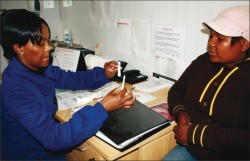
Q: WHY SHOULD WE ALL BE EXCITED ABOUT A MICROBICIDE? AND WHAT IS A MICROBICIDE, ANYWAY?
It is a funny-sounding, maybe even scary word, isn’t it? It sounds powerful and scientific, and that might turn people off and make you think it’s boring — but it isn’t at all. The CAPRISA gel microbicide is a groundbreaking innovation that empowers women to protect themselves from HIV.
Q. HOW DOES IT WORK?
CAPRISA gel works in much the same way that spermicidal foams and gels prevent the risk of pregnancy. First, they are both female-controlled chemical barriers, meaning women can use them without the participation of their partner. Second, the microbicides in CAPRISA gel act as chemical barriers against HIV/AIDS when women use the gel before potential exposure to the virus, reducing their risk of infection.
Q. WHY IS IT IMPORTANT THAT WOMEN CAN DO THIS?
I think people know that there is large number of people around the world with HIV. It’s 33.3 million. But women and girls make up a growing proportion of those infected by HIV/AIDS. In 2004, the United Nations estimated that in sub-Saharan Africa, young women aged 15 to 24 were three times more likely to be infected than young men of the same age.
We also know that in many countries, women lack the power to negotiate the use of prevention tools and approaches to protect themselves from exposure to HIV/AIDS through conventional methods such as condom use, reducing their number of sexual partners, and negotiating delay of sexual debut. CAPRISA will help empower these women so they have more control over their own health decisions.
Q. YOU SAID IT WAS PROVEN THIS YEAR, WHAT DOES THAT MEAN?
Like many things in science, we run lots of tests and studies to make sure things are safe and effective. As scientists, we’d say these trials are encouraging. But we need to confirm these results in further studies. Once this happens, we could have on our hands a unique HIV/AIDS prevention tool for women who are not able to negotiate other HIV/AIDS prevention methods with their male partners. We could be witnessing the future of HIV/AIDS prevention. Once this new technology is ready, USAID will work with all our partners to make it available to vulnerable women and girls as soon as possible.







Comment
Make a general inquiry or suggest an improvement.